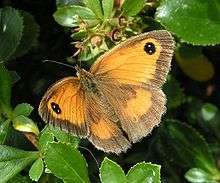Satyrini
The Satyrini are a huge tribe of the Satyrinae butterflies, containing the graylings, ringlets, and allies. They belong to the Nymphalidae (brush-footed) family. The classification used here is based on the new work by Wahlberg et al. (based on Savela 2007[1])
| Satyrini | |
|---|---|
 | |
| Gatekeeper butterfly, Pyronia tithonus | |
| Scientific classification | |
| Kingdom: | Animalia |
| Phylum: | Arthropoda |
| Class: | Insecta |
| Order: | Lepidoptera |
| Family: | Nymphalidae |
| Subfamily: | Satyrinae |
| Tribe: | Satyrini |
| Subtribes | |
| |
Selected genera
Subtribe Coenonymphina
- Coenonympha
- Heteronympha
- Lyela Swinhoe, 1908
- Sinonympha Lee, 1974
- Triphysa Zeller, 1850
Subtribe Dirina
Subtribe Erebiina
- Erebia Dalman, 1816
- Proterebia Roos & Arnschied, 1980 (tentatively placed here)
Subtribe Euptychiina
- About 44 genera, see article for details.
Subtribe Hypocystina
- 19 genera, see article for details.
Subtribe Maniolina
- Aphantopus Wallengren, 1853
- Cercyonis Scudder, 1875
- Hyponephele Muschamp, 1915
- Maniola Schrank, 1801
- Pyronia Hübner, 1819
Subtribe Melanargiina
- Melanargia Meigen, 1828
Subtribe Parargina Tutt, 1896[2]
Subtribe Pronophilina
- Altopedaliodes Forster, 1964
- Apexacuta Pyrcz, 2004
- Argyrophorus Blanchard, 1852
- Arhuaco Adams & Bernard, 1977
- Auca
- Calisto
- Catargynnis Röber, 1892
- Cheimas Thieme, 1907
- Chillanella Herrera, 1966
- Corades Doubleday, [1849]
- Cosmosatyrus C. & R.Felder, 1867
- Daedalma Hewitson, 1858
- Dangond Adams & Bernard, 1979
- Diaphanos Adams & Bernard, 1981
- Drucina Butler, 1872
- Druphila Pyrcz, 2004
- Elina Blanchard, 1852
- Etcheverrius Herrera, 1965
- Eretris Thieme, 1905
- Eteona Doubleday, 1848
- Faunula C. & R.Felder, 1867
- Foetterleia Viloria, 2004
- Gyrocheilus Butler, 1867
- Haywardella Herrera, 1966
- Homoeonympha C. & R.Felder, 1867 (including Erebina and Stygnolepis)
- Ianussiusa Pyrcz & Viloria 2004
- Idioneurula Strand, 1932 (including Tamania)
- Junea Hemming, 1964
- Lasiophila C. & R.Felder, 1859
- Lymanopoda Westwood, 1851 (including Sabatoga)
- Manerebia Staudinger, 1897
- Mygona Thieme, 1907
- Nelia Hayward, 1953
- Neomaenas Wallengren, 1858 (including Spinantenna)
- Neopedaliodes Viloria, Miller & Miller, 2004
- Neosatyrus Wallengren, 1858
- Oxeoschistus Butler, 1867
- Palmaris Herrera, 1965
- Pampasatyrus Hayward, 1953 (including Pseudocercyonis)
- Pamperis Heimlich, 1959
- Panyapedaliodes Forster, 1964
- Paramo
- Parapedaliodes Forster, 1964
- Pedaliodes Butler, 1867
- Pherepedaliodes Forster, 1964
- Physcopedaliodes Forster, 1964 (including Antopedaliodes and Corderopedaliodes which are apparently valid genera)
- Praepedaliodes Forster, 1964
- Praepronophila Forster, 1964
- Proboscis
- Pronophila Doubleday, [1849]
- Protopedaliodes Viloria & Pyrcz, 1994
- Pseudomaniola Röber, 1889
- Punapedaliodes Forster, 1964
- Punargentus Heimlich, 1963
- Quilaphoetosus Herrera, 1966
- Redonda
- Sierrasteroma Adams & Bernard, 1977
- Steremnia Thieme, 1905
- Steroma Westwood, [1850]
- Steromapedaliodes Forster, 1964
- Stuardosatyrus Herrera & Etcheverry, 1965
- Tetraphlebia C. & R.Felder, 1867
- Thiemeia Weymer, 1912
Subtribe Satyrina
- Arethusana de Lesse, 1951
- Argestina Riley, 1923
- Aulocera Butler, 1867
- Austroypthima Holloway, 1974
- Berberia
- Boerebia Prout, 1901
- Brintesia Fruhstorfer, 1911
- Callerebia Butler, 1867
- Cassionympha van Son, 1955
- Chazara
- Coenyra Hewitson, 1865
- Coenyropsis van Son, 1958
- Davidina Oberthür, 1879
- Hipparchia (including Parahipparchia)
- Kanetisa Moore, 1893
- Karanasa
- Loxerebia Watkins, 1925
- Mashuna van Son, 1955
- Melampias Hübner, 1819
- Minois Hübner, 1819
- Neita van Son, 1955
- Neocoenyra Butler, 1886
- Neomaniola Hayward, 1949
- Neominois Scudder, 1875
- Oeneis
- Paralasa Moore, 1893
- Paroeneis Moore, 1893
- Physcaeneura Wallengren, 1857
- Pseudochazara
- Pseudonympha Wallengren, 1857
- Satyrus
- Strabena Mabille, 1877
- Stygionympha van Son, 1955
- Ypthima Hübner, 1818
- Ypthimomorpha van Son, 1955
Setodocis Billberg, 1820 is apparently a nomen dubium.
gollark: Haskell is of course capable of Discord bots.
gollark: But at least Python lets you implement trees which work for any type and such.
gollark: Which... I mean, sure, if you want that?
gollark: I consider it basically just faster and stupider Python targeted at webapps.
gollark: Because we know the !!TRUTH!! about Go?
References
| Wikimedia Commons has media related to Satyrini. |
- Savela, Markku (2007). Markku Savela's Lepidoptera and some Other Life Forms: Satyrinae. Version of 12 May 2007. Retrieved 31 May 2007.
- Parargina, Tree of Life web project
This article is issued from Wikipedia. The text is licensed under Creative Commons - Attribution - Sharealike. Additional terms may apply for the media files.